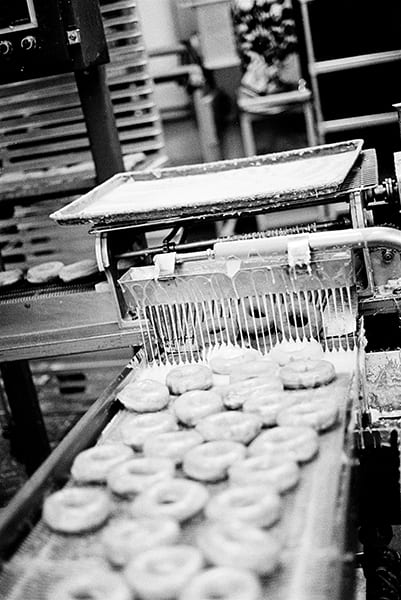We conclude our thematic week on #BODY with an AVMoFA entry by Paul Mullins & mass-produced desire via the Doughnut Machine. How exactly were doughnuts historically transformed into mass produced goods and just through what kind of senses do they awaken popular desire?
Few foods have been as unapologetically mass-produced than the doughnut. While doughnut consumers nurse complicated feelings for particular brands and local shops or celebrate one variety while castigating others, the doughnut is an enormously standardized and predictable food; indeed, that standardization, the anonymity of its ingredients, and its bold acknowledgement that a doughnut is a pure food of desire may be what critics loathe about the doughnut. The contemporary doughnut is almost entirely a mass-produced food, and perhaps no material thing is more important in the evolution of the modern doughnut than doughnut machines. In the 1920’s doughnut production was mechanized—a skilled baker would not need to even touch a doughnut in the 1930s—and this was probably the single most important step in doughnuts’ ascension to mass-consumed food.
Adolph Levitt arrived in the United States in the 1890’s, trying his hand running Wisconsin department stores before heading to New York City in 1916 and buying into a bakery chain. Levitt was discouraged by the practical challenges of forming hundreds of doughnuts by hand and then lording over them as they bobbed about in hot oil. Levitt enlisted an engineer to help him produce a doughnut-making machine, and in 1920 they developed a prototype that was installed in Levitt’s Harlem window and marketed to other bakers. Levitt began hawking doughnut machines and prepared flour mixes all over the country, and his local doughnut shop soon mushroomed into a series of stores that came to be known as Mayflower Doughnuts.

Levitt understood that for many doughnut consumers the literal act of production was fascinating theater: a doughnut machine in open display to the waiting consumer became a sort of pleasant anticipation that heightened desire as a consumer awaited the freshly made treat. Doughnut aficionados routinely intone that a fresh doughnut is far superior to a reheated or cold doughnut, and for many consumers there is a distinctive and desirable sensory excitement in watching doughnuts march through a little factory production machine amidst the scent of yeast and sugar.
We do not seem especially interested in seeing many of our foods being produced by either a skilled chef or an automated process, but a doughnut floating across a sea of boiling oil has often been an attraction for doughnut consumers.
Levitt’s standardization of doughnut machines and his marketing of prepared doughnut supplies took nearly all the surprise out of doughnut consumption, since there was very little variation between doughnuts formed by doughnut machines. This sort of streamlining is now standard organization among fast-food chains—a Big Mac or a Krispy Kreme doughnut all taste pretty much the same regardless of where we consume them—so the doughnut machine was clearly at the cutting edge of a revolution in how foods could be mass-produced and consumed. By the end of World War II Levitt’s Doughnut Corporation of America was the world’s largest maker of doughnut mixes and bakery goods, with factories in the US, Canada, England, and Australia. They charted a steady increase in the quantity of doughnuts being consumed in the US, indicating that Americans consumed 7.2 billion doughnuts in 1945. Today by one count roughly 10 billion doughnuts are consumed each year.

It is perhaps ironic that in the early 21st century a host of doughnut producers has now turned to the manufacture of gourmet doughnuts. Gourmet doughnut shops run by professionally trained chefs use a host of organic and artisanal materials and make creative if idiosyncratic flavors (e.g., Glazed Gourmet Doughnuts offers up a Blue Cheese Cabernet Doughnut with homemade pear jam, Cabernet glaze, and blue cheese honey drizzle). These doughnuts perhaps defy the machine-made doughnut that dominated markets for nearly a century, instead appealing to a consumer’s desire for culinary creativity and a unique consumption experience breaking with the mass-produced glazed doughnut. However, all evidence suggests that while cosmopolitan foodies flock to gourmet doughnuts the masses are likely going to continue to consume the mass-produced doughnut made in machines that have not changed much in a century.




